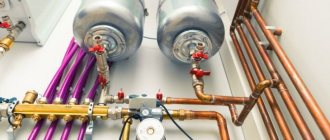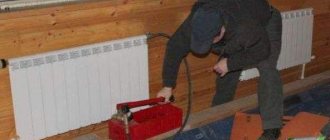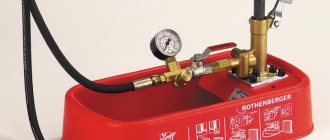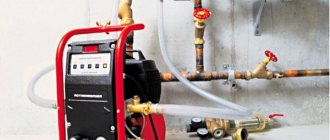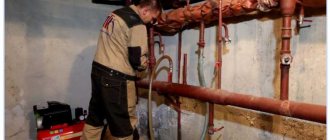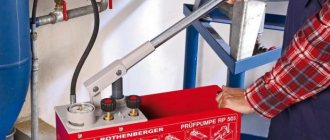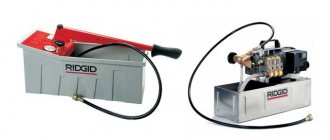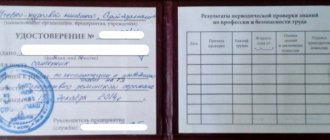In order for the heating main to operate without failures, it is important not only to correctly assemble and install the system elements, but also to carry out commissioning work. The commissioning package includes pressure testing of the heating system, flushing of pipes and other work. The procedures are carried out in accordance with regulatory requirements and are carried out both for autonomous systems put into operation for the first time, and for heating mains during preparation for the heating season. Let's look at what pressure testing is, why hydrotesting is needed, and how the work is done.
Why is hydro testing necessary?
Hydrotesting – checking the integrity and tightness of the heating main. Testing allows you to timely detect leaks and gaps at the points of threaded connections of fittings and battery connections, which can lead to leakage and flooding. Hydraulic tests are a mandatory measure at the stage of preparing pipelines for commissioning.
Important! If there is no certificate of testing the system in the building, the heat supply organization has the right to refuse to supply heat to the system.
The companies operating the structure are informed about the period of testing. The process is carried out by specialized companies whose employees have the necessary qualifications. Preparation of heat supply systems includes pressure testing of the main line and flushing of pipelines.
Permissible test pressure when testing water heating
Many developers are interested in what pressure should be used to check the heating system. In accordance with the SNiP requirements presented above, during pressure testing, pressure is allowed to be 1.5 times higher than the working pressure , but it should not be less than 0.6 MPa.
There is another figure indicated in the “Rules for the technical operation of thermal power plants.” Of course, this method is “softer”; its pressure exceeds the working pressure by 1.25 times.
In private houses equipped with autonomous heating, it does not rise above 2 atmospheres, and it is adjusted artificially: if excess pressure appears , the relief valve immediately turns on. Whereas in public and multi-apartment buildings the working pressure is much higher than these values: five-story buildings - about 3-6 atmospheres, and tall buildings - about 7-10.
What is crimping?
Pressure testing is a test in which the pipeline and batteries are held under excess pressure for a certain time. All structural elements and components are tested for strength, including radiators, shut-off and control valves, pumping stations, heat exchangers, etc.
Important! Strength testing is carried out annually for all heat supply systems, including heat supply units to the building, ITP, heating systems, boiler rooms, and so on. The inspection period is determined by regulatory organizations.
Similar materials on the company website
Plastic rotameters EMIS-META 210 / 210R - Rotameter Technical characteristics Plastic rotameters EMIS-META 210 / 210R Type: Rotameter Measured...
Control station for three pumps IRZ-670-90 - Pump control system Technical characteristics Control station for three pumps IRZ-670-90 Type : Pump control system…
Dimensions of polypropylene pipes Before purchasing polypropylene pipes, you should first of all carefully...
Test procedure according to regulations
Hydrotesting of the heating system, as well as other components of the main line, is regulated by the regulatory framework. Let's consider the recommendations on SNiP.
SNiP 41-01-2003:
- the temperature in the building during work must be above +0 C;
- the maximum pressurized pressure should not be higher than the maximum pressure for the equipment and materials used to construct the heating system;
- the pressure test value is 50% higher than the operating pressure of the system and equipment (at least 0.6 MPa).
SNiP 3.05.01-85:
- Hydraulic tests of large components of systems are carried out at the assembly site.
- If the pressure drops during pressure testing, visual inspections of the line must be carried out to detect leaks. After the leak has been eliminated, continue leak testing activities.
- If there are valves or wedge valves in the pipeline system, pressure testing is carried out by turning the control knob twice.
- Sectional radiators and other non-factory-assembled heating system devices are pressure tested on site.
- When laying a pipeline with hidden wiring, a leak test is performed at the indicated high pressure before finishing work. If it is intended to thermally insulate pipelines, tests are carried out before installing thermal insulation on the system elements.
- Hot water boilers and membrane tanks are switched off at the time of inspection.
The test is considered passed if the operability of the system is confirmed within 30 minutes - the pressure testing has not decreased and no leaks are visually detected in the design.
Purpose and principle of operation of a hydraulic arrow for heating
On a note! Determining the correctness and uniformity of heating of the main line is called a thermal test, which is carried out for 7 hours while maintaining the temperature of the coolant from +60 C.
If during the warm season the coolant cannot reach the pressure test temperature, thermal tests are postponed until the temporary supply of heat is supplied or until the main line is connected to the source of heat.
Important! The results of hydraulic tests are entered into the pressure test report. If work was carried out to test the hidden installation pipeline, then the report is supplemented with a sheet for hidden work.
Stages of work completion
Before carrying out work, it is important to find out how pressure testing of the heating system occurs. The process proceeds according to a scheme common to all systems; in particular, the following procedure is assumed:
- The area being tested is switched off using cranes.
- The operation of the heat generator is suspended.
- The coolant is being drained.
- Water at a temperature not exceeding 450C is poured into the circuit; for this purpose, there is a pipe at the bottom of the system.
- During the process of filling the circuit with water, air is released.
- Connect a device that will pump pressure into the system.
- After reaching the operating pressure level, visually inspect the system for integrity.
- Trying to avoid jerks, increase the pressure to the test level and record the sensor readings.
- The system should remain at this pressure for about 10 minutes.
- Re-inspect the system, identifying leaks and fogging at joints using soldering, welding or fittings. They also search for ruptures and fistulas in individual components, including the valve body, radiator sections and walls of pipe sections, and check the operation of taps and shut-off valves.
- Check pressure sensor readings. The test can be considered successful if the pressure readings remain unchanged. If pressure testing of the central heating reveals leaks, then you should drain the water from the circuit, repair the weak area and repeat the process.
- The results of testing the system for density and strength are recorded in a special document. Therefore, it is important to know how to correctly write a heating system pressure test report.
Procedure and features of pressure testing of heating systems
Regulatory acts regulate pressure testing of the heating system under various pressures, determined by the type of equipment used and the purpose of the line.
In particular:
- the heat supply unit to the building requires a pressure of 16 atmospheres;
- Heating supply structures, ventilation, ITP, thermal circuits in multi-storey buildings are pressurized under a pressure of 10 atmospheres;
- autonomous circuits in private houses under a pressure of 2-3 atmospheres;
- highways in new buildings require a pressure supply of 1.5-2 times higher than the operating indicators;
- highways in old, dilapidated buildings are pressurized with reduced performance by 1.15-1.5 times;
- if cast iron batteries are installed in the building, the pressure range cannot be higher than 6 atmospheres, for systems with convectors - no more than 10 atmospheres.
Advice! To determine the permissible level of pressure testing, you need to read the technical data sheets of the equipment. The maximum permissible pressure along the weakest element of the line is selected.
The procedure for crimping work is as follows:
- Fill the line with water. If during operation it is intended to use antifreeze as a coolant, then pressure testing is performed first with water, and only then with antifreeze.
Important! Aqueous solutions with additives based on ethylene glycol or propylene glycol have low surface tension and are considered more fluid than water. Therefore, if a leak occurs during crimping using antifreeze, the connections need to be tightened slightly.
- When preparing the existing heating system for the season, the coolant is drained, then the pipeline and radiators are filled with clean water. The structure must be filled with liquid through the lowest point of the boiler room or heating unit, where the drain ball valve is installed.
- During the process of filling the water, the valves are opened to bleed air. These can be auto-ventilators on heating risers, at the upper points of a pipeline branch, or Mayevsky taps on batteries.
Important! To prevent airing, filling with water is carried out only according to the bottom-up scheme.
- After filling the water, the required pressure is injected. The process should be monitored with measuring pressure gauges. At the same time, a visual inspection of components and pipelines is carried out to detect leaks.
Advice! If the pipelines are covered with condensation during the period of filling with water, the elements are dried and the inspection can be continued. Particular attention is paid to components and structures hidden in building forms.
- After reaching the maximum permitted pressure test, keep the system for at least 30 minutes. If there are no leaks and the standard pressure is maintained without a drop in level for half an hour, the system is recognized as having passed pressure testing.
Advice! If the pressure drops by no more than 0.1 atmospheres within the specified half hour, a visual inspection does not show any leaks, and the pressure test is also considered completed.
If leaks or other defects in the line are detected during hydraulic testing, the system is repaired, then tests are carried out over a new one. After completion of the pressure testing, a certificate of pressure testing work is drawn up and signed in accordance with the form of regulatory documents.
Equipment and test frequency
Pressure testing of centralized systems is carried out by personnel using standard equipment, so it is hardly worth talking about. But not everyone probably knows about the costs of private heating and water supply. These are special pumps. There are two types - manual and electric (automatic). Manual pressure testing pumps are autonomous, the pressure is pumped up using a lever, and the created pressure is controlled using a pressure gauge built into the device. Such pumps can be used for small systems - pumping is quite difficult.
Flushing heating systems
It is necessary to wash the structural components before putting the circuit into operation during the heating season. Flushing is required to remove hardness salts and deposits inside the pipeline and thermal elements that accumulate during constant intensive work. Scale reduces the internal cross-section of structures, which leads to an increase in hydraulic resistance and reduces the heat transfer of heating devices.
Air-to-air heat pumps for heating a private home
On a note! Scale 1 mm thick reduces the heat transfer of radiators and pipelines by 15-20%. If the coolant is supplied to the system at a constant high temperature, salt deposits lead to local overheating and the formation of fistulas.
In order to prevent a decrease in the energy efficiency of the main, flushing should be done once a year, like pressure testing - before putting the thermal structure into permanent operation or at the time of the initial commissioning of the system.
Sometimes in an autonomous heating system it happens that the pipeline is hot, but the radiators have not yet warmed up - this is the first sign of a clogged line. Increased fuel consumption will also help determine the need for flushing.
The principle of flushing is simple - the old coolant is drained from the system, then clean water is supplied, and the supply must be under pressure to increase the speed of the coolant and create turbulent fluid flows. In areas where sediment accumulates, the flows will provide vortex vibrations, and dirt will be washed out along with the water.
Important! To protect the compressor from water during operation, you need to install a check valve and close the system air bleeder valve. You can wash using special descaling compounds.
Heat supply flushing methods
It is not recommended to start flushing the heating system without preliminary preparation. It is necessary to determine the chemical composition of scale and select a specific type of equipment for cleaning.
A technological map that prescribes all stages of the procedure will help you correctly complete the necessary steps. The latest regulation ends with the treatment of the internal area of the pipes with a chemical composition to prevent the appearance of corrosion, lime deposits, and scale.
The main washing methods are the following:
- chemical method;
- hydrodynamic;
- hydropneumatic.
Chemical flushing of coolant
This method does not involve the intervention of mechanical devices and the dismantling of radiators. Cleaning is carried out with chemicals or solutions.
However, using the method can damage the inner plane of aluminum radiators, which can lead to their destruction.
If the heating network is not very clogged, you can use the following reagents:
- sodium hydroxide;
- vinegar essence;
- ordinary phosphoric or condensed acid;
- whey.
However, it is better to use compounds that allow you to thoroughly clean the pipes. The instructions for the preparations specify the material and the nature of the layers.
Chemical treatment can be carried out using additional equipment - a booster, consisting of a centrifugal pump and a large container. The first one is connected at the break in the centralized supply system with the heating boiler. A valve must be installed at the outlet of the circuit to discharge the spent chemical.
For high-quality corrosion of lime deposits, experts recommend leaving the reagent in the network for several days, depending on its slagging level. However, to avoid exposure of the pipes to the chemical, the circuit must be rinsed with industrial or tap water after cleaning.
A more gentle metal structure is the dispersed cleaning mode. The method differs from the chemical method in that the reagent destroys the mechanical bonds of the deposits themselves, without interacting with the material of the heating communications.
Hydrodynamic cleaning
The described operation is carried out using specialized equipment. One of them is a powerful centrifugal pump with a hose having a small diameter end nozzle. Strong water pressure cleans scale and deposits from the walls of heating mains and removes them through the return line.
The disadvantage of this method is the impossibility of passing the hose around the turns of the system without opening the heating unit in many places.
Mechanical flushing method
Method for cleaning radiators and small pipes. The shut-off valves, expansion tank and centrifugal pump must be cleaned separately. Before the procedure, it is necessary to carry out a minimal drain of the house system, and then close the inlet and drain valves. Only after this they begin to reset the rest of the media.
The discharge occurs through a drain valve installed in the basement, which communicates with the sewer through a hose. This will prevent the technical subfloor from flooding with water. Radiators are cleaned by unscrewing the plug and dumping the media. However, removing the battery and processing will improve the thermal performance of the radiator.
After dismantling the radiators and areas of heating distribution to the yard, the equipment is cleaned with a cable with a brush-shaped tip. The tool is inserted into the batteries in the reverse position to the supply of thermal resources to improve the removal of scale flakes and deposits. Cleaning is carried out until the rinsing water becomes clear.
Hydropneumatic
Belongs to an effective and equipment-friendly method for cleaning heating circuits. Contains a high pressure air jet. The compressor creates high-power turbulent flows inside the communications, leading to the breakdown of build-ups and washing out accumulated dirt.
The operation is performed with a pneumatic gun that delivers short-term impulses. Lime deposits are discharged through open radiator plugs. The initial purge procedure is performed against the flow of the coolant, and the repeat procedure is performed clockwise. Removing batteries and cleaning them outside will improve air operations.
Electrohydropulse cleaning option
The method is based on the formation of an electric discharge, the shock wave of which breaks up lime deposits on the internal walls of the system, without causing harm to the latter. To carry out cleaning, you will need a voltage generator and a coaxial cable to supply high-frequency signals.
The efficiency of the method is high, so the dismantling of radiators and the entire heating circuit is not provided. After the scale is destroyed, the coolant is washed and the water goes down the drain.
Who can carry out pressure testing?
In new buildings, responsibility is assigned to contractors, and in the case of preparing an already working system, the inspection is carried out by the organization responsible for maintaining all engineering systems of the facility.
The rules for conducting pressure testing and other testing processes are determined by housing legislation. Regulations apply to all management companies, regardless of the type of building in which they are required to carry out work.
In facilities of administrative and state significance, inspections and tests are carried out by the operating organization or by a contractor who has approvals and work permits.
Operational testing of heating networks
6.82.
Heat networks in operation must be subjected to the following tests: hydraulic tests to check the strength and density of pipelines, their elements and fittings;
tests for the maximum temperature of the coolant (temperature tests) to identify defects in pipelines and equipment of the heating network, monitor their condition, check the compensating ability of the heating network;
heat loss tests to determine the actual heat losses of heat pipes depending on the type of building and insulating structures, service life, condition and operating conditions;
hydraulic loss tests to obtain hydraulic characteristics of pipelines;
tests for stray current potentials (electrical measurements to determine the corrosive aggressiveness of soils and the dangerous effect of stray currents on pipelines of underground heating networks).
All types of tests must be carried out separately. Combining two types of tests in time is not allowed.
6.83. To conduct each test, a special team is organized, headed by a test manager, who is appointed by the chief engineer.
At the discretion of the organization's management, specialized organizations with appropriate licenses may be involved in testing heating networks for heat and hydraulic losses and for the presence of stray current potentials.
The test manager must determine in advance the necessary activities that must be performed in preparing the network for testing. These activities include:
insertion of fittings for pressure gauges and sleeves for thermometers;
insertion of circulation jumpers and bypass lines;
selection of measuring instruments (pressure gauges, thermometers, flow meters, etc.) for each measurement point in accordance with the expected limits of the measured parameters in each test mode, taking into account the terrain, etc.
6.84. For each type of test, a work program must be drawn up, which is approved by the chief engineer of the OETS.
When receiving thermal energy from a heat source owned by another organization, the work program is agreed upon with the chief engineer of this organization.
Two days before the start of the tests, the approved program is transferred to the OETS dispatcher and the head of the heat source to prepare the equipment and establish the required operating mode of the network.
The test work program must contain the following data:
objectives and main provisions of the test methodology;
list of preparatory, organizational and technological measures;
the sequence of individual stages and operations during the test;
operating modes of the heat source equipment and heating network (flow rate and parameters of the coolant during each stage of the test);
operation diagrams of the pump-heating installation of the heat source under each test mode;
switching and switching diagrams in the heating network;
timing of each individual stage or test mode;
observation points, object of observation, number of observers at each point;
operational means of communication and transport;
safety measures during testing;
a list of responsible persons for the implementation of individual activities.
6.85. Before starting the test, the test director must:
check that all preparatory measures have been completed;
organize verification of the technical and metrological condition of measuring instruments in accordance with regulatory and technical documentation;
check the disconnection of branches and heating points provided for by the program;
instruct all team members and shift personnel on their responsibilities during each individual stage of the test, as well as measures to ensure the safety of direct test participants and surrounding persons.
6.86. A hydraulic test for the strength and density of heating networks in operation must be carried out after major repairs before the start of the heating period. The test is carried out along separate lines extending from the heat source with the water heating installations of the heat source turned off, heat consumption systems turned off, and with open vents at consumers' heating points. The mains are tested in whole or in parts, depending on the technical ability to provide the required parameters, as well as the availability of operational means of communication between the OETS dispatcher, the personnel of the heat source and the team conducting the test, the number of personnel, and the availability of transport.
6.87. Each section of the heating network must be tested with a test pressure, the minimum value of which must be 1.25 working pressure. The operating pressure value is set by the technical manager of the OETS in accordance with the requirements of the Rules for the Construction and Safe Operation of Steam and Hot Water Pipelines.
The maximum value of the test pressure is set in accordance with the specified Rules and taking into account the maximum loads that can be assumed by the fixed supports.
In each specific case, the test pressure value is set by the technical manager of the OETS within the acceptable limits specified above.
6.88. During a hydraulic test for strength and density, the pressure at the highest points of the heating network is brought to the test pressure value due to the pressure developed by the network pump of the heat source or a special pump from the pressure testing point.
When testing sections of the heating network in which, due to the terrain profile conditions, network and stationary pressure testing pumps cannot create a pressure equal to the test pressure, mobile pumping units and hydraulic presses are used.
6.89. The duration of test pressure tests is set by the chief engineer of the OETS, but must be at least 10 minutes. from the moment the flow of make-up water is established at the calculated level. Inspection is carried out after the test pressure has been reduced to operating pressure.
The heating network is considered to have passed the hydraulic test for strength and density if, when left in place for 10 minutes. under a given test pressure, the recharge value did not exceed the calculated one.
6.90. The temperature of water in pipelines when testing for strength and density should not exceed 40 degrees. C.
6.91. The frequency of testing the heating network for the maximum temperature of the coolant (hereinafter referred to as temperature tests) is determined by the head of the OETS.
The entire network from the heat source to the heating points of the heat consumption systems must be subjected to temperature tests.
Temperature tests must be carried out at stable daily above-zero outside air temperatures.
The maximum temperature should be taken as the maximum achievable temperature of the supply water in accordance with the approved temperature schedule for regulating heat supply at the source.
6.92. Temperature tests of heating networks that have been in operation for a long time and have unreliable sections should be carried out after repair and preliminary testing of these networks for strength and density, but no later than 3 weeks before the start of the heating period.
6.93. The water temperature in the return pipeline during temperature tests should not exceed 90 degrees. C. High-temperature coolant must not enter the return pipeline to avoid disrupting the normal operation of network pumps and the operating conditions of compensating devices.
6.94. To reduce the temperature of the water entering the return pipeline, tests are carried out with heating systems turned on, connected through mixing devices (elevators, mixing pumps) and water heaters, as well as with hot water supply systems turned on, connected in a closed circuit and equipped with automatic temperature controllers.
6.95. During temperature tests, the following must be disconnected from the heating network:
heating systems of children's and medical institutions;
non-automated hot water supply systems connected in a closed circuit;
hot water supply systems connected in an open circuit;
heating systems connected through elevators with mixing coefficients that are lower than the calculated ones;
heating systems with direct connection;
heater installations.
The shutdown of heat points and heat consumption systems is carried out first on the heating network side by valves installed on the supply and return pipelines of heat points, and in case of leakage of these valves, by valves in chambers on branches to heat points. In places where valves do not provide shutoff density, it is necessary to install plugs.
6.96. Tests to determine heat losses in heating networks should be carried out once every five years on main lines that are characteristic of a given heating network by type of building and insulating structures, service life and operating conditions, in order to develop standard indicators and normalize operational heat losses, as well as assess technical condition of heating networks. The test schedule is approved by the technical manager of OETS.
6.97. Tests to determine hydraulic losses in water heating networks should be carried out once every five years on pipelines that are typical for a given heating network in terms of terms and conditions of operation, in order to determine operational hydraulic characteristics for the development of hydraulic modes, as well as assess the condition of the internal surface of pipelines. The test schedule is established by the technical manager of OETS.
6.98. Tests of heating networks for heat and hydraulic losses are carried out with the branches of heating points of heat consumption systems disconnected.
6.99. When conducting any tests, subscribers must be notified three days before the start of the tests about the time of testing and the period for shutting down heat consumption systems, indicating the necessary safety measures. The warning is given against signature to the responsible person of the consumer.
>Hydraulic testing of heating network pipelines - pressure testing
How much do hydraulic tests cost?
Knowing how to pressurize a heating system, it will not be difficult for the owner of a private house to carry out the work on his own, but this solution is not optimal, especially when launching a new autonomous highway. It is better to contact a specialized company, whose master will show you all the stages of the procedure and tell you the nuances of the work.
The cost depends on the complexity of the process, the length and condition of the heating system. If the procedure is supplemented by washing, replacing metering and measuring instruments and eliminating leaks, then the service will cost more. On average, testing an apartment building will cost from $400 (from 30,000 rubles), a mansion will cost from $200 (15,000 rubles), one apartment on average from $65 (5,000 rubles).
Important! When inviting a master, the owner must receive a contract for the work, an estimate and, upon completion of the crimping, a report drawn up in the form, as well as a guarantee for all types of services provided.
Heating water supply boiler room
LLC DESIGN PRESTIGE > https://resant.ru/
Telephone: 8(495)744-67-74
We provide installation services for heating and water supply systems for private country houses, dachas, and organizations. We supply equipment for work at discounts.
Our services:
Heating:
Installation, design, service repair. Heating by type: autonomous, water, private, wood, individual, gas, natural.
Water supply:
Autonomous water supply from a well and a borehole. Installation of a water supply system for both permanent and temporary residence and use of the house. We provide maintenance of water supply systems: pump replacement, replacement, repair of hydraulic accumulator, setting up automatic pump control.
- Replacing a pump in a well
Boiler room:
For private homes and industrial enterprises. We will install the boiler, distribution modules for heating circuits, and install automation elements for temperature control.
We carry out all work on a turnkey basis. LLC DESIGN PRESTIGE
LLC DESIGN PRESTIGE.
| Repair of apartments , country houses , roofing , foundations , fences , fencing , autonomous gasification , private sewerage , facade finishing water supply systems from wells and boreholes, professional modern boiler rooms for private homes and businesses . |
| Systems: heating , water supply , sewerage . Full construction . |
| Holding company SpetsStroyAlliance |
| Laying , repair and installation of heating networks , turnkey heating mains For private homes and businesses . |
Air bleeding devices
Air that appears in the circuit for one reason or another must be removed. To bleed air trapped in the system, use a heating air vent, which can be manual or automatic.
Manual air vent
A manual air vent, better known as a Mayevsky tap, is installed only in apartments on heating radiators due to its low throughput. Typically, such valves are installed on all radiators, and they ensure the bleeding of air from the heating system during setup and operation.
Automatic air vent
Automatic float-type air vents operate as follows. If the system is operating in normal mode, the float completely closes the valve opening, but if an air lock occurs in the system, the float opens the valve. The open valve of the automatic air vent releases air from the heating system, then rises again and closes the valve. Of course, the use of automatic air vents facilitates the operation of systems, but they require systematic maintenance and cleaning of various contaminants present in the water.
Execution of hydropneumatic testing process
Pressure testing and flushing of the heating system is mandatory work. They are considered preventive measures and help to test the heating system in any residential apartment building.
Pressure testing of the heating system is performed after the heating season ends. In most regions of Russia, the heating season ends in April. During this period, the condition of the shut-off valves is checked, the riser pipelines, thermal and elevator units are checked.
To eliminate problematic blockages in the risers, flushing is carried out. Before flushing, the following preparatory work must be done:
- Check elevators, risers and main pipelines.
- Inspect all elements of the heating system, detect leaks and fix them.
- Check the thermal insulation of risers, mains and basements.
At heating units, preparatory measures are carried out after preparing the heating system, because hydraulic tests of the heating unit must be carried out at high pressure, exceeding the pressure in the heating system.
Hydropneumatic tests are carried out in the following sequence:
- First, the heating system is filled with water.
- Then you need to connect a press that performs pressure testing of the heating system.
- Then the pressure gauge readings are checked.
About half an hour after connecting the pump used for pressure testing of the heating system, it is necessary to monitor the pressure readings. If they remain unchanged, it means that the heating system has excellent sealing and is considered pressurized.
When the pressure indicated on the scale decreases, it means that the heating system is leaking. In this case, it is necessary to find leaks, eliminate them and repeat the test. The input unit is tested separately using a pressure of 1 MPa.
There are two types of pumps used for pressure testing of the heating system:
- Manual;
- Electrical.
Upon completion of pressure testing and flushing of the heating system, a report form is filled out by a representative of the organization responsible for heat supply and a representative of the heating networks. Forms for the heating system pressure testing report are available from representatives of the heating service.
The heating system is checked for hardness by an inspector. He takes a sample of the network fluid from the tap and, after conducting a laboratory analysis, tests the water for the amount of magnesium and calcium salts. Network water must meet the hardness standard of 75-95 units. The heating system is considered ready for operation when the network water has normal parameters.
Sequence of air removal in high-rise buildings
For multi-storey buildings, the problem of when and how to properly bleed air from the heating system is solved as follows. Air usually rises and accumulates in radiators and piping on upper floors. But before the heating season, checking and removing air must be done sequentially, starting from the lower floors.
If you install an automatic air vent for heating radiators on the heating radiator and in problem areas, it will ensure air bleed. Of course, you can check the system manually, it won’t make you worse, because... the valve may become dirty or stuck, which will prevent the automatic release of air from the heating system and disrupt the operation of the circuit.
